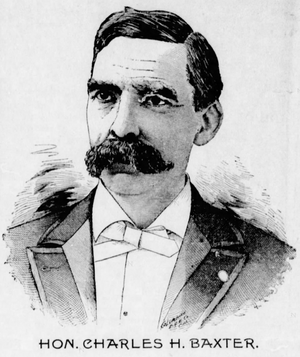Charles H. Baxter facts for kids
Quick facts for kids
Charles H. Baxter
|
|
|---|---|

Portrait of Charles H. Baxter from an 1898 campaign advertisement.
|
|
| Member of the Wisconsin Senate from the 16th district |
|
| In office January 2, 1893 – January 7, 1901 |
|
| Preceded by | Edward I. Kidd |
| Succeeded by | Edward E. Burns |
| Personal details | |
| Born | November 15, 1841 Stillwater, New York, U.S. |
| Died | December 23, 1923 (aged 82) Lancaster, Wisconsin, U.S. |
| Political party | Republican |
| Spouse |
Maria Howe
(m. 1865–1923) |
| Children |
|
| Military service | |
| Allegiance | United States |
| Branch/service | United States Army Union Army |
| Years of service | 1862–1865 |
| Rank | Captain, USV |
| Unit |
|
| Battles/wars | American Civil War |
Charles Henry Baxter (born November 15, 1841 – died December 23, 1923) was an American businessman and politician. He was a member of the Republican Party.
Baxter served for eight years in the Wisconsin State Senate. He represented Grant County and nearby areas. He was also the mayor of Lancaster, Wisconsin. During the American Civil War, he was an officer in the Union Army.
Contents
Early Life and Moving West
Charles H. Baxter was born in Stillwater, New York, in 1841. When he was 16, in 1857, his family moved to Grant County, Wisconsin. His father became a well-known doctor there.
Charles went to public schools in both New York and Wisconsin. In 1861, he started working as a clerk in a store in Lancaster, Wisconsin. But soon, a big war started, and he decided to join the army.
Serving in the Civil War
In 1862, Charles Baxter joined the Union Army. He was part of the 25th Wisconsin Infantry Regiment. This group was made up of volunteers from southwest Wisconsin.
Before fighting in the Civil War, his regiment was sent to Minnesota. They helped protect settlers during a conflict called the Sioux uprising.
Later in 1862, his regiment went south to join the Civil War. They took part in the Siege of Vicksburg from June to July 1863. This was a very important battle. After Vicksburg, they guarded areas in Kansas. Many soldiers got sick with malaria, and Charles also became ill. He had to leave the army in August 1863 to recover.
After getting better, Charles joined the army again in 1864. This time, he was with the 41st Wisconsin Infantry Regiment. They were sent to Memphis, Tennessee. Their job was to guard railroads and supply lines.
While in Memphis, Charles worked for General Cadwallader C. Washburn. The only battle they saw there was in August 1864. A group of enemy soldiers tried to capture General Washburn, but they failed. Charles's regiment served for 100 days and then finished their service.
Charles decided to serve one more time. He joined the 47th Wisconsin Infantry Regiment as a captain. In 1865, they went to Kentucky and Tennessee. They mostly did guard duty, protecting different areas. Charles was in charge of supplies for a part of Tennessee. The war ended while he was in this role, and he left the army in September 1865.
Life After the War
After the war, Charles Baxter returned to Lancaster. He worked with his former boss, George Howe, in a business called "Howe & Baxter." Charles later married George Howe's daughter, Maria.
When George Howe retired, Charles took over the business. He renamed it "Charles H. Baxter & Co." They sold many different things, like lumber, coal, and farm animals. Charles retired from this business in 1895.
After retiring from his business, Charles became involved in banking. He was elected vice president of the State Bank of Grant County. Later, he became the president of the bank.
Political Career
Charles Baxter was very active in the Republican Party of Wisconsin. He led the Republican committee in Grant County for 20 years. He also served on the state party committee for eight years.
He was a member of the Grant County Board of Supervisors. He also served on the Lancaster village board. When Lancaster became a city, Charles Baxter was elected its 7th mayor in 1888.
In 1892, Charles was elected to the Wisconsin State Senate. He was re-elected in 1896. He served as a state senator from 1893 to 1900. In the Senate, he led the committee that handled claims against the state. He also worked on committees for state affairs, banking, insurance, and military matters.
Charles continued his work at the State Bank of Grant County. In 1903, his bank joined with another bank to form Union State Bank. He became the vice president of this new bank. In 1912, he became its president and stayed in that role until he passed away in 1923.
Family Life
Charles H. Baxter married Maria Howe on February 20, 1865. They had three children together: George, Laura, and Martha. When Charles passed away in 1923, his wife, all his children, and three grandchildren were still living.

